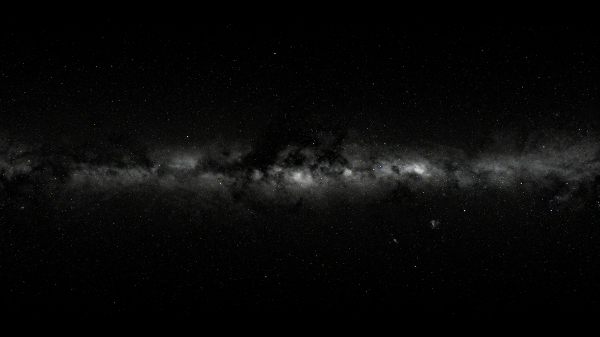Finding our place in the Galaxy – and the Universe
Science highlights from the Hipparcos mission
Measuring the positions of celestial bodies in the sky is an ancient activity that has engaged astronomers for millennia. The practice of astrometry, which first allowed the assessment of distances to the stars in the nineteenth century, paved the way to ESA's Hipparcos mission, the first satellite launched to chart the heavens. The scientific harvest of this mission was extraordinarily rich, ranging from studies of the life cycles and interiors of stars to their motions in the Galaxy, from the physics of the Solar System to cosmology.
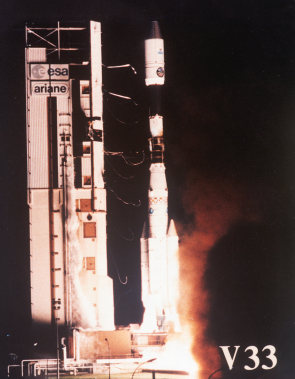 |
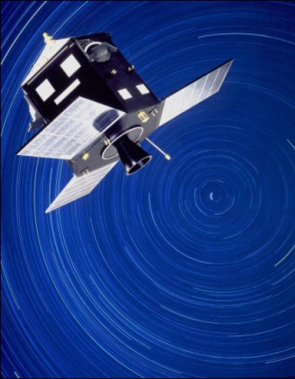 |
| Launch of Hipparcos. Credit: ESA | Artist's impression of Hipparcos. Credit: ESA |
ESA's Hipparcos satellite was the first space mission entirely dedicated to astrometry. Launched in 1989 and operating for over three years, Hipparcos elevated this time-honoured discipline to cutting-edge science, escaping the limits imposed on ground-based observations by Earth's atmosphere and ushering astrometry into the twenty-first century.
From the highly precise measurements performed with Hipparcos, astronomers compiled a catalogue of 117 955 stars, reporting their positions with an accuracy of 0.001 arc seconds. Measuring how a star's position varies over one year, astronomers can measure its parallax – an apparent, periodic change in stellar positions caused by Earth's motion around the Sun. From parallaxes, they can determine the distances of stars, which is one of astronomy's toughest challenges. The positions of stars exhibit also an additional, very slow variation, called proper motion; in contrast to the apparent effect of parallax, proper motion is a direct result of stars moving through the Galaxy.
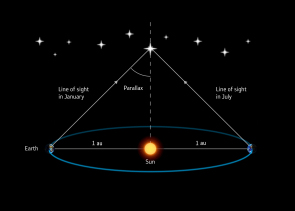 |
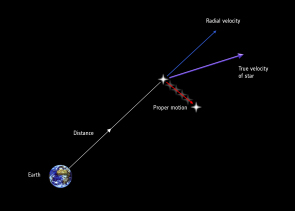 |
| The parallax method of measuring stellar distances. Credit: ESA |
Illustration depicting stellar motion. Credit: ESA/ATG medialab |
The Hipparcos catalogue, published in 1997, was a huge advance on the best catalogues compiled from ground-based observations. It contains the position and parallax of stars with a precision of one thousandth of one arc second (and proper motions with a precision of one arc second per year), allowing astronomers to estimate distances to stars out to a few hundred light-years away. The results from the Hipparcos mission changed forever the way astronomers look at the life of stars, the dynamics of the Galaxy and the age of our expanding Universe.
Distances to characterise the stars
The knowledge of stellar distances is fundamental to estimate and calibrate other key properties of stars. The enormous improvement in accuracy achieved with Hipparcos revealed that many stellar parameters – ranging from their fluxes and effective temperatures to their masses and sizes – had been only poorly known.
Many stars are born in binary or multiple systems, and Hipparcos revealed that these are even more common than previously thought; astronomers estimate that there are billions of them across our Galaxy. Binary stars are especially interesting because astronomers can exploit their relative motions to estimate stellar masses – something that cannot be achieved for a single star. With Hipparcos, astronomers detected and measured masses of 235 binary stars.
Over time, Hipparcos advanced the understanding of virtually all types of stars – from massive to low-mass ones, from proto-stars to evolved stars and stellar remnants like white dwarfs. For the first time, astronomers had a vast and robust data set to describe a wide variety of stars, spanning all evolutionary stages in stellar life. This pushed them to refine the models that describe the evolution as well as the internal structure of stars.
Distances to measure the Universe
In addition to providing crucial insight into the life of stars, the stellar census performed with Hipparcos also had major implications for cosmology. While the parallax of stars is the only direct method to measure distances to astronomical sources, it has a limited range of applicability. To gauge the cosmos over larger scales, astronomers need to rely on indirect methods to estimate distances; these methods are, in turn, calibrated using 'local' stars whose distances are known via parallax.
Data from Hipparcos were used to measure the parallax for a large sample of Cepheids, a type of variable stars used widely to estimate distances since their intrinsic luminosity can be evaluated from the period of their variations. These studies revealed that most of our neighbouring stars are in fact further away than had been estimated.
Cepheid stars are used to estimate the distances of nearby galaxies – a first step to chart the expanding Universe. The improved calibration of this cosmic distance ladder made possible by Hipparcos allowed cosmologists to refine their estimate of the expansion rate of the Universe, revealing that cosmic expansion proceeds slower than previously thought.
Measuring distances, dating the cosmos
This new, lower value of the cosmic expansion rate suggested that the Universe might be about 14 billion years old, a few billion years older than was thought at the time. Until then, determining the age of the Universe had been problematic because of a discrepancy with the age of globular clusters – clusters of stars that are the oldest building blocks of our Galaxy. Before Hipparcos, the most ancient components of the Galaxy seemed to be older than the Universe itself. The new estimate of the age of the Universe, together with new studies based on Hipparcos observations of stars in globular clusters – proving that the clusters are younger than previously thought – finally solved this long-standing conundrum.
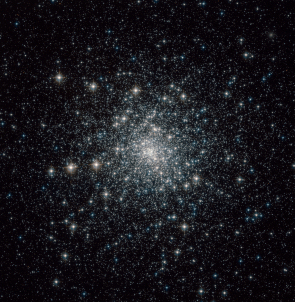 |
| Hubble's view of the globular cluster Messier 30. Credit: NASA/ESA |
The downward revision of the age of globular clusters is only one of the many results made possible by Hipparcos in the study of stellar clusters. Clusters of stars are key to understanding stellar evolution as they give astronomers the opportunity to investigate large numbers of stars that cover a broad range of masses and evolutionary stages and that can be assumed to have all been born at the same time and to have all the same chemical composition. They include both globular clusters, which contain up to a few million stars that are tightly bound to one another, and open clusters, which are much younger and contain only hundreds to thousands of loosely bound stars.
One of the closest open clusters to Earth is the Hyades cluster, at a distance of only 151 light years. Astronomers used Hipparcos to scrutinise the Hyades cluster in great detail: by measuring distances to many of its individual stars for the first time, they could reconstruct the cluster's three-dimensional structure and study its dynamics. They could also improve the estimate of its age, which is now known to be about 625 million years.
Distances and proper motions to probe the Milky Way
While the parallaxes measured by Hipparcos helped astronomers to pinpoint the three-dimensional structure of stars in our galactic neck of the woods, with the proper motions they could evaluate the velocities of these stars, too. This allowed them to study the structure of the Milky Way's spiral arms and how the stars in them move.
Analysing stellar motions, astronomers can investigate the gravitational field through which stars move, assessing how much matter is there and how it is distributed. Using data from Hipparcos, they reconstructed the gravitational potential in the solar neighbourhood, showing that the way stars move agrees well with the observed distribution of both stars and gas. This result ruled out that large amounts of (invisible) dark matter are lurking in the plane of our Galaxy.
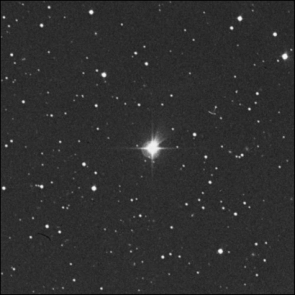 |
|
One of the stars from the fossil clump dating back to the early days of the Milky Way. Credit: ESA |
Delving into the Hipparcos catalogue, astronomers were also able to identify groups of stars that move along the same "waves" across the spiral arms of the Milky Way. In particular, they identified a small clump of extremely old stars that are still moving on very similar orbits – a fossil relict of one of our Galaxy's first building blocks. This was one of the first proofs that galaxies build up in a hierarchical way, through the merging of smaller structures into increasingly larger ones.
Hipparcos data were also used to refine the estimate of the Sun's velocity – about 220 kilometres per second – and its orbit through the Galaxy. During its galactic revolution lasting about 226 million years, our parent star oscillates only slightly above and below the Milky Way's disc. Without peeping out of the disc, the Sun is shielded from the highly energetic X-rays and gamma rays that dominate in the less dense outer environment, which has crucial implications for the emergence and survival of life on our planet. Were it not for this added protection, there might not be any astronomers to research it.
Worldly and otherworldly successes
Hipparcos scored successes even in areas of astronomy that could neither have been foreseen at the time of the mission planning nor at launch. When Hipparcos launched, astronomers were still six years away from detecting their first exoplanet. Yet, years later, astronomers have exploited data from the Hipparcos catalogue to obtain upper limits for the masses of several planets outside our Solar System. As well as confirming that those detections correspond to true planetary systems, these data allowed astronomers to determine the masses of the planets and to characterise the properties of their parent stars.
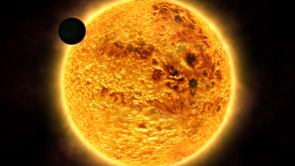 |
| Artist's impression of an exoplanet. Credit: ESA, NASA and Frédéric Pont (Geneva University Observatory) |
From a more Earthly perspective, the Hipparcos catalogue was used to define an accurate and homogeneous reference frame on the sky. This system is still routinely employed as reference for ground-based telescopes to find their targets, as well as by the star-trackers that are used for the navigation of spacecraft.
The science highlights presented in this article are just a selection from the multitude of studies and discoveries that were made possible by the unprecedented data recorded with Hipparcos. With results spanning from stellar interiors and evolution to the dynamics of our Galaxy and the physics of the Solar System, Hipparcos greatly exceeded its initial scientific goals, demonstrating the great potential offered by space-based astrometry and paving the way to ESA's billion-star surveyor, Gaia, which was launched on 19 December 2013.

